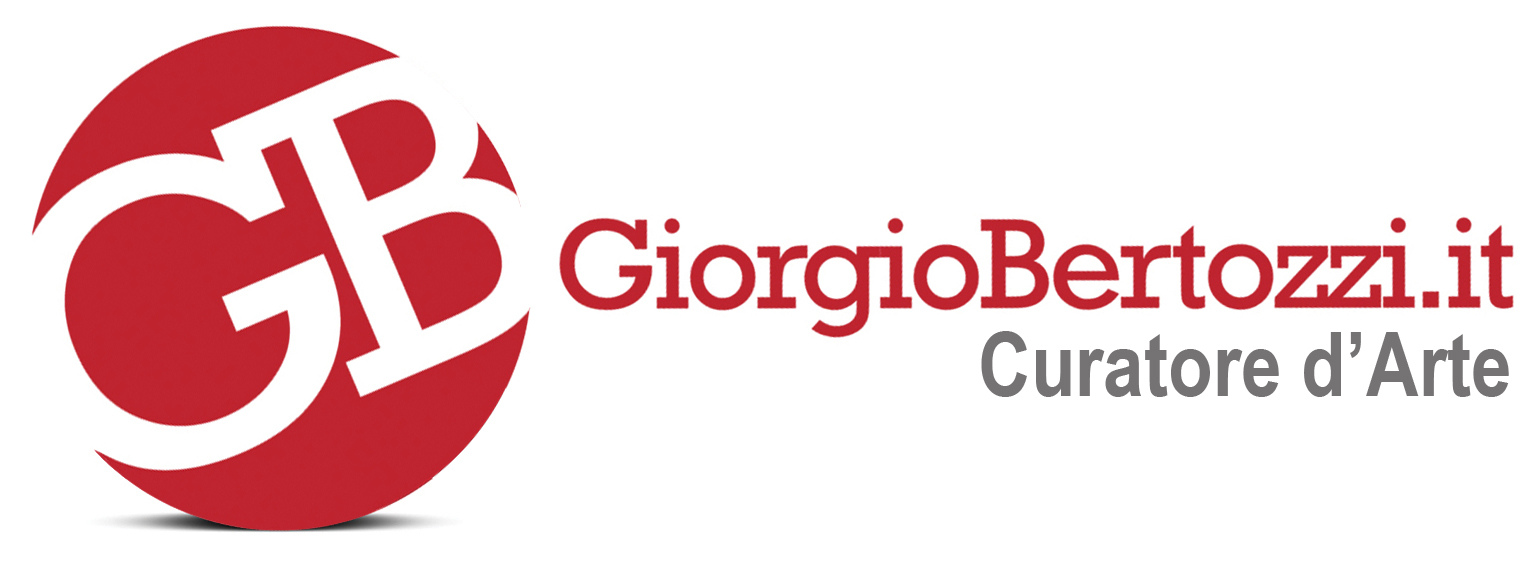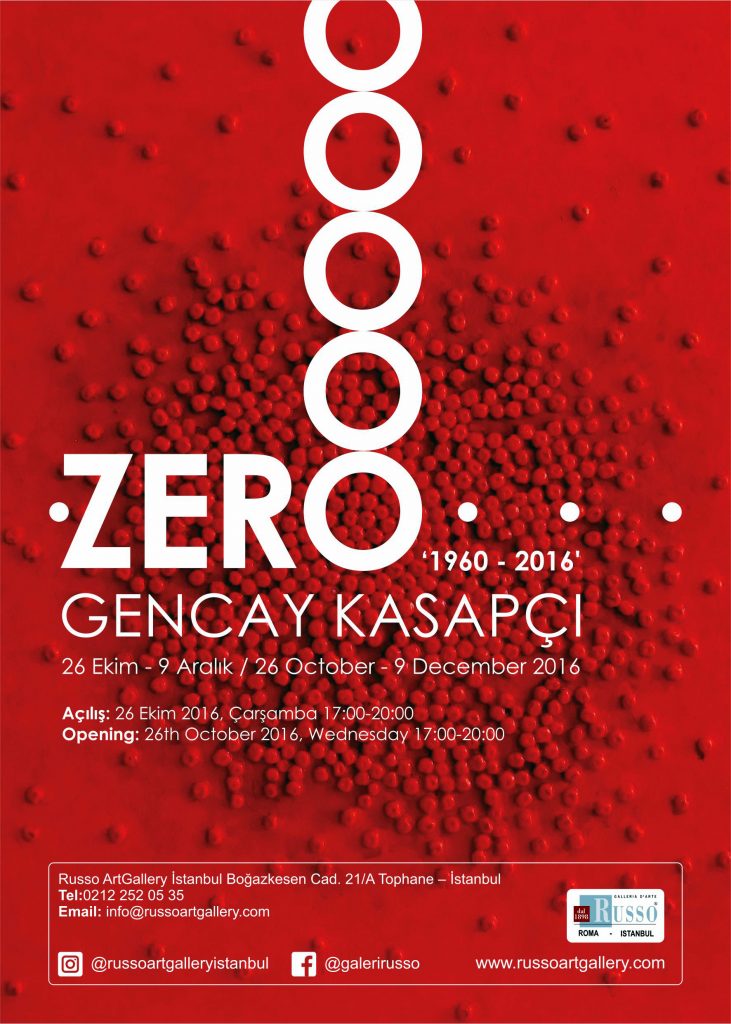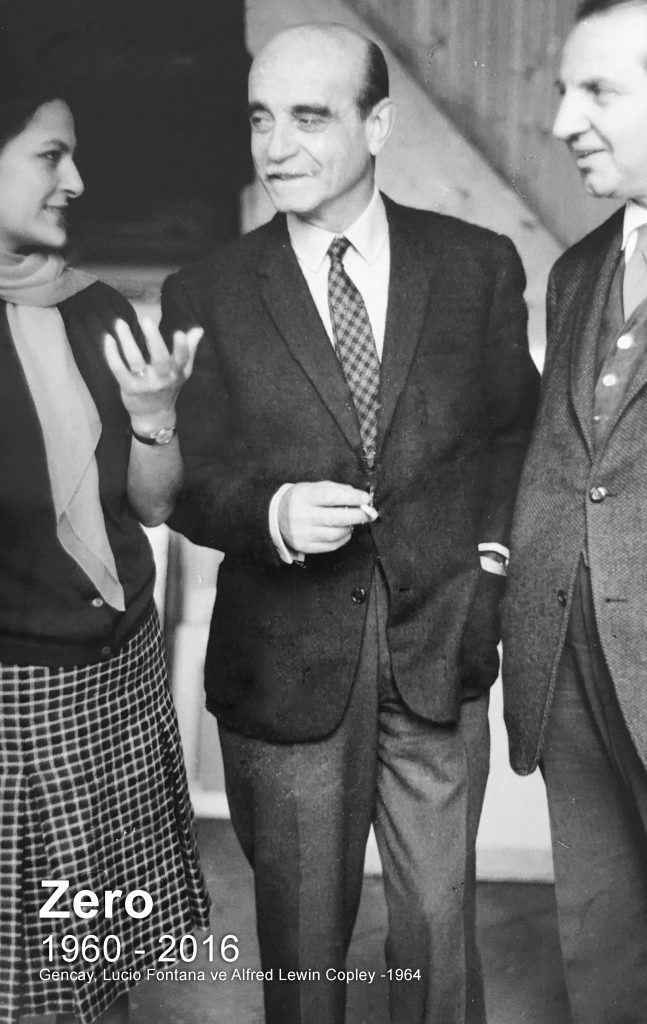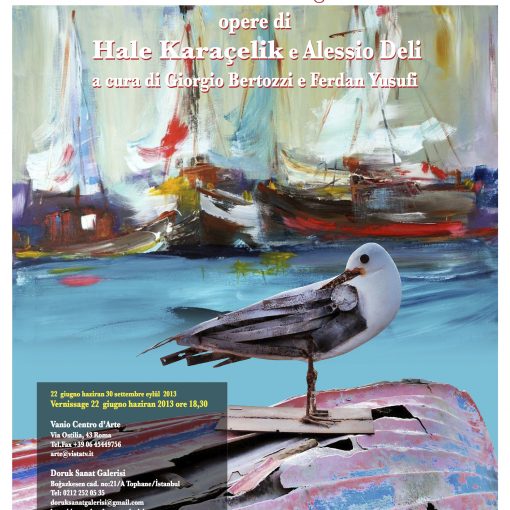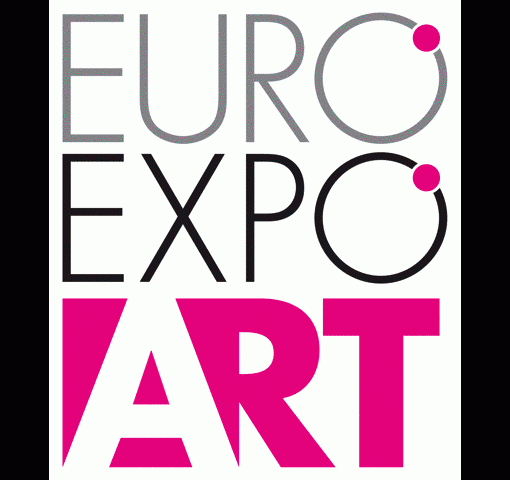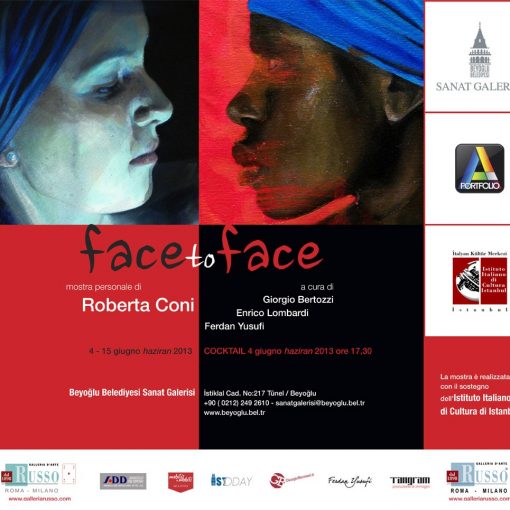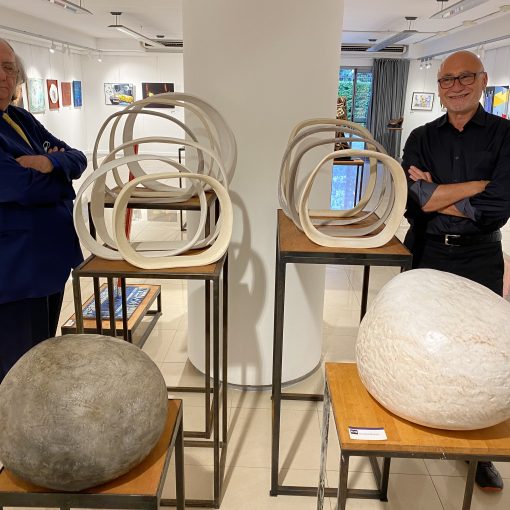Zero 1960 2016 Gencay Kasapçı
Zero è un movimento artistico d’avanguardia nato con lo scopo di risollevare l’ambiente depresso dalla seconda guerra mondiale con la creazione di un clima più entusiasta e positivo e con un nuovo dinamismo di luce nell’arte. Zero è un movimento dove gli artisti si esprimono da zero a classico, sondando ogni direttrice possibile per il post-guerra. Zero nasce nel 1957 con le attività Heinz Mack e Otto Pienne di Dusseldorf e ha continuato a diffondersi attraverso artisti come Yves Klein, Daniel Spoerri, Gunther Uecker e Tinguely . Heinz Mack, con le sue opere ha incrementato nel movimento tecniche ed impiego di materiali: tela in bianco e nero e alluminio, acciaio inox, plexiglass, schiuma, realizzando effettivamente un modo nuovo di pensare applicato alla sua arte con dinamiche innovative. Gli artisti che preferiscono partire da zero come una via d’uscita dalla cultura tedesca che ha perso la sua essenza nel periodo bellico avvicinano le loro opere ad un mondo in bianco e nero, separando le loro tele e le loro reazioni, con le creazioni, attraverso un diverso impiego della luce, senza limitarsi a dipingere la luce stessa. Questo movimento iniziato in Germania dopo la seconda guerra mondiale, ha presentato i suoi effetti in primo luogo in Europa, poi in America e quindi in Giappone e ha creato una rete internazionale d’arte. Zero è visto come una manifestazione di colore, stupore e individualità mantenendo negli anni i principi e gli effetti come uno dei movimenti più importanti dell’arte mondiale. Zero ha stabilito una forte rete dal punto zero in cerchi concentrici con le sue mostre, la critica e gli artisti si è diffuso in Francia con Arman, Jean Tinguely e Yves Klein, in Spagna con Antoni Tapies, in Australia con Arnulf Rainer, in Italia con Lucio Fontana, Piero Manzoni , Turi Simetri e Agostino Bonalumi e ha continuato a diffondersi in America con Gesù Rafael Soto, Luis Tomasello e Almir MAVIGNIER. “Le espressioni artistiche degli Anni ’50 avevano creato in Europa un ambiente contaminato da flussi di pensiero molto diversi tra loro. In questo clima confuso e continuamente bombardato da nuovi impulsi di pensiero nasce la voglia di silenzio, il desiderio di azzeramento. Ed è proprio da questa forte esigenza che a Dusseldorf nacque il Gruppo Zero. Nella rivista del gruppo, creata nel 1958, Piene spiegò come “Zero” fosse un termine scelto per l’intenzione di ripartire da capo, azzerando tutte le esperienze artistiche conosciute fino a qual momento per creare silenzio e purezza. «Zero è silenzio. Zero è inizio. Zero è rotondo. Il sole è Zero. Zero è bianco (…) Zero è l’occhio. La bocca. Il buco del culo (…) oro e argento, rumore e vapore. Circo nomade. Zero. Zero è silenzio. Zero è inizio. Zero è rotondo. Zero è Zero», così scriveva Otto Piene nel 1963. Lo spettatore quindi non è tenuto a capire l’opera, né a leggerne la descrizione di un sentimento dell’artista, ma diventa parte attiva, è spinto a scoprire l’oggetto attraverso diversi punti di vista che ne modificano l’essenza. Gli aderenti al Gruppo Zero inizialmente producono opere monocrome, segno di pulizia e azzeramento e l’anno della nascita del Gruppo Zero coincide anche con l’anno della creazione dell’“International Klein Blue”, il tono di blu con il quale Klein, diventato esponente importantissimo per il Gruppo, realizzava le sue pitture monocrome.” Movimento Zero si è sviluppato nutrendosi di alcuni fattori fondamentali di arte moderna e ha tenuto mostre con il contributo degli artisti di molte parti del mondo. Il movimento è ancora oggi influente e molti Zero artisti che usano elementi come la meccanica, il colore, la luce, l’ottica continuano le loro carriere indipendenti. Questo movimento è influente ovunque ed è stato introdotto in Turchia da Gencay Kasapçı che ha operato in Italia con i maestri fondatori di Zero. Dopo la laurea Accademica, Genkay ha proseguito la sua vita artistica ad Ankara e Istanbul, successivamente, nel 1959, la troviamo a Firenze. In quegli anni inizia il suo lavoro con opere astratte ed inizia la partecipazione alle alle mostre del gruppo ZERO firmandosi Gencay. Il nome di Gencay Kasapçı è presente su invito di ZERO nella mostra dal titolo “avanguardia “ del 1966 con Heinz Mack, Yves Klein, Otto Piene, Günther Uecker ma già era presente a Milano nel 1962, con artisti che hanno contribuito a rafforzare l’anima del gruppo ZERO, come Tinguilly e Lucio Fontana. Gencay Kasapçı vive in Turchia e ad Istanbul ci presenta tutto il percorso, che, dalle grandi mostre con i Maestri ZERO l’ha portata ai giorni nostri ‘Zero 1960-2016’
Gencay Kasapçı: A quest for Aesthetic Perfection.
As someone who has had the privilege of following the artist’s work evolve for over four decades it is a source of inspiration to reflect on her intricate explorations, her quest for new aesthetic dimensions. Without shifting paradigms her work became a launching pad towards new expressions following a trajectory that strived to capture the infinite and the ephemeral at the same time. In the dawn of her career as an artist in the early sixties, a period marked by a creative revival with the emergence of new movements such as Zero, Kasapçı was able to define her artistic idiom which she deployed for over fifty years. This idiom, which often one can easily see as transcending style, is so powerful that it can provide a sound platform on which the artist has been able to experiment with a multitude of expressions. The challenging dichotomies between the constant and variable, between the synchronic and the diachronic, between void and mass, have been the unceasing driving force behind her work. The subtle variations within the orderly, the diversity within the monotony have marked her work ever since and even today, after five decades, is as powerful as ever. Her art proves once again that the value of art can be measured not by the exasperating search for virtuosity and the burst of signs and symbols, of stylistic excesses but instead by the sobriety of the expression, the strength of the fundamental tenets of artistic expression, constant in history. In an era marked by the confusion of idioms, of stylistic contradictions, of crisis of creativity it is soothing to experience Kasapçı’s art, anchoring one’s perception to sound aesthetic grounds that epitomize the evolution of art from the early modernist epoch. The abstract motion in her art work makes one think of Lucinda Child’s choreography of Phillip Glass’ music back in the early 1970’s. Child’s choreography often described as conceptual is marked by simple minimalist movements, beautiful in their spatial explorations. In her dances one can see the splendour of the different patterns the human body can create across a stage by fundamental repeated movements such as skipping and turning. In her dances she was able to create an entire performance piece based on one simple combination that would be repeated numerous times but in different ways. Her choreography, just as Kasapçı’s art, transcends time. Art today is afflicted by a multitude of problems, stemming from the state of art education to the forces steering the art market but never in history has the artistic realm been so free of codes and restrictions. Perhaps this absolute freedom is the greatest challenge to artists, at times inhibiting their creativity, not to mention the demographic challenges of emerging from a crowd. It is in this difficult context that the artist pursued her artistic life not giving away to facile formulae or sensationalist gestures, instead following a coherent path of analysis and creativity setting her aside from the mainstream of fad following artists. It is this uniqueness that gives her work all accolades of value. It is indeed a great source of pleasure to be able to see all her work in one exhibition, to detect her artistic path, to grasp the essence of each phase, the intellectual evolution and the aesthetic outcomes. This is a unique event that will reward the art lover with a very rich experience.
Gencay Kasapçı: Estetik Mükemmelliğin Arayışı
Sanatçının kırk yılı aşkın işlerinin evrimine tanıklık etmenin ayrıcalığını yaşamış birisi olarak onun kavramsal arayışları, yeni estetik boyutların denemeleri üzerlerinde düşünmek gerçekten bir ilham kaynağı olmaktadır. Onun çalışmaları paradigma değişimlerine gitmeden yeni ifadelere ulaşmak için adeta bir hareket noktası gibi sonsuzluğu ile günceli yakalamaya çalışan bir yol haritası izledi. Altmışlı yılların başlarında kariyerinin şafağında, yaratıcılığın yeniden canlandığı ve Zero gibi yeni hareketlerin doğduğu bir dönemde Kasapçı kendine özgün bir dil geliştirmeyi başarmış ve bunu neredeyse elli yıldır kullanabilmiştir. Bu dil o kadar güçlü ki her türlü stil kalıbını aşmış ve sonsuz ifade biçimlerinin arayışına olanak veren sağlam bir temel olabilmiştir. Durağan ile değişken, eşzamanlı ile diyakroniğin, kütle ile boşluğun oluşturduğu zorlu ikilemler sanatçının çalışmaları için tükenmez bir güç kaynağı olmuştur. Düzenlinin içinde ince değişimler, tekdüzeliğin içinde farklılıkların varlığı çalışmalarını yönlendirmiş ve bugün bile elli yıl sonra aynı gücünü korumuştur. Sanatçının çalışmaları bir kez daha göstermiştir ki sanat değerini ölçerken virtüözlüğün çaresiz arayışı ya da simge ve işaretlerin patlama noktasına getirilmesi ya da stil abartmalarıyla değil ifadenin itidali ve tarih boyunca geçerliliğini koruyan sanatın ana ilkelerinin geçerli olduğudur. Yaratıcılık krizlerinin, dil kargaşalığının ve stil çelişkilerinin yaşandığı çağımızda güçlü estetik temellere dayanarak algılanabilen bir bağlamında modern sanatın ilk evrelerinden özümsenerek yaratılmış olan Kasapçının sanatını izlemek gerçekten çok güven ve huzur veren bir deneyim. Onun yapıtlarındaki soyut hareketler 1970’li yıllarda Phillip Glass’ın müziğine koreografi yapan Lucinda Child’I düşündürüyor. Kavramsal olarak nitelenen Child’in koreografileri çok basit minimalist hareketlerle mekânsal arayışları aracılıyla estetik değerini yakalamaktadır. Danslarında sahne boyunca insan bedeninin atlamak ve dönmek gibi temel hareketlerle yaratabildiği farklı motiflerin görkemini algılamak mümkün. Danslarında farklılıklar sergileyen ama birçok kez tekrarlanan basit kombinasyonlarla tüm bir gösteriyi sürdürebiliyordu. Koreografisi Kasapçının sanatı gibi zamanı aşan bir boyuta sahip idi. Sanat bugün birçok sorunsallıkla baş etmek durumunda; bunlar, sanat eğitiminden başlayan ve sanat pazarına kadar uzanan krizleri içermektedir. Ne var ki sanat tarih boyunca hiçbir kuralın ya da kısıtlamanın söz konusu olmadığı bu denli özgür bir ortam bulamamıştır. Belki de bu aşırı özgürlük sanatçı için en büyük engeli teşkil ediyor sanki yaratıcılığı kısıtlıyor. Bir başka zorluk ise çok kalabalık bir kitlenin içinden sıyrılmak. Sanatçı işte bu zorlu bağlamda çalışmalarını yürütüyor ve de bunu yaparken basit formüllerden ya da göz kamaştırmaya yönelik hareketlerden uzak duruyor. Tutarlı bir yol izleyerek analizine ve yaratıcılığına sadık kalarak kendini modalara uyan sanatçılardan ayırarak çalışmalarını yürütebiliyor. İşte sanatına onca değeri veren bu benzersiz yaklaşımıdır. Sanatçının eserlerini topluca görmek gerçekten çok büyük keyif veriyor. Onun sanatsal yolculuğunu izlemek, her aşamasının özünü kavrayabilmek ve de entelektüel gelişimini ve onun estetik çıktılarını izleyebilmek çok heyecan verici ve sanatseverler için çok aydınlatıcı ve zenginlik katan bir deneyim olacaktır.
